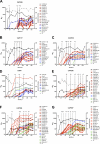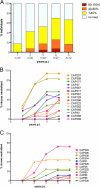The neutralization breadth of HIV-1 develops incrementally over four years and is associated with CD4+ T cell decline and high viral load during acute infection
- PMID: 21389135
- PMCID: PMC3126191
- DOI: 10.1128/JVI.00198-11
The neutralization breadth of HIV-1 develops incrementally over four years and is associated with CD4+ T cell decline and high viral load during acute infection
Abstract
An understanding of how broadly neutralizing activity develops in HIV-1-infected individuals is needed to guide vaccine design and immunization strategies. Here we used a large panel of 44 HIV-1 envelope variants (subtypes A, B, and C) to evaluate the presence of broadly neutralizing antibodies in serum samples obtained 3 years after seroconversion from 40 women enrolled in the CAPRISA 002 acute infection cohort. Seven of 40 participants had serum antibodies that neutralized more than 40% of viruses tested and were considered to have neutralization breadth. Among the samples with breadth, CAP257 serum neutralized 82% (36/44 variants) of the panel, while CAP256 serum neutralized 77% (33/43 variants) of the panel. Analysis of longitudinal samples showed that breadth developed gradually starting from year 2, with the number of viruses neutralized as well as the antibody titer increasing over time. Interestingly, neutralization breadth peaked at 4 years postinfection, with no increase thereafter. The extent of cross-neutralizing activity correlated with CD4(+) T cell decline, viral load, and CD4(+) T cell count at 6 months postinfection but not at later time points, suggesting that early events set the stage for the development of breadth. However, in a multivariate analysis, CD4 decline was the major driver of this association, as viral load was not an independent predictor of breadth. Mapping of the epitopes targeted by cross-neutralizing antibodies revealed that in one individual these antibodies recognized the membrane-proximal external region (MPER), while in two other individuals, cross-neutralizing activity was adsorbed by monomeric gp120 and targeted epitopes that involved the N-linked glycan at position 332 in the C3 region. Serum antibodies from the other four participants targeted quaternary epitopes, at least 2 of which were PG9/16-like and depended on the N160 and/or L165 residue in the V2 region. These data indicate that fewer than 20% of HIV-1 subtype C-infected individuals develop antibodies with cross-neutralizing activity after 3 years of infection and that these antibodies target different regions of the HIV-1 envelope, including as yet uncharacterized epitopes.
Figures








References
-
- Baba T. W., et al. 2000. Human neutralizing monoclonal antibodies of the IgG1 subtype protect against mucosal simian-human immunodeficiency virus infection. Nat. Med. 6:200–206 - PubMed
-
- Binley J. 2009. Specificity of broadly neutralizing antibodies in sera from HIV-1 infected individuals. Curr. Opin. HIV AIDS 4:364–372 - PubMed
-
- Blish C. A., Nedellec R., Mandaliya K., Mosier D. E., Overbaugh J. 2007. HIV-1 subtype A envelope variants from early in infection have variable sensitivity to neutralization and to inhibitors of viral entry. AIDS 21:693–702 - PubMed
Publication types
MeSH terms
Substances
Grants and funding
LinkOut - more resources
Full Text Sources
Other Literature Sources
Medical
Research Materials
Miscellaneous

